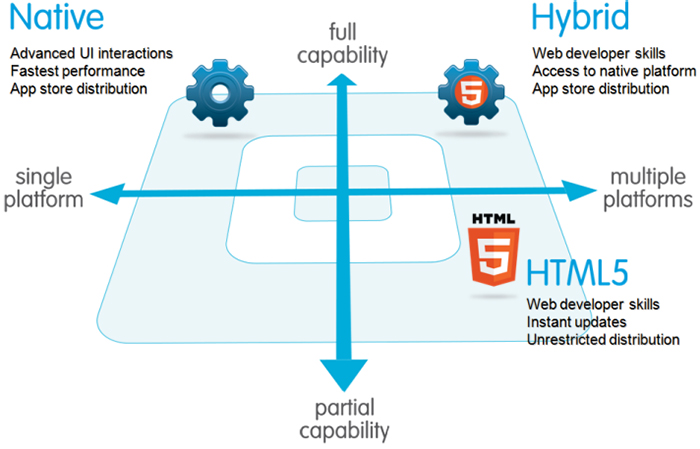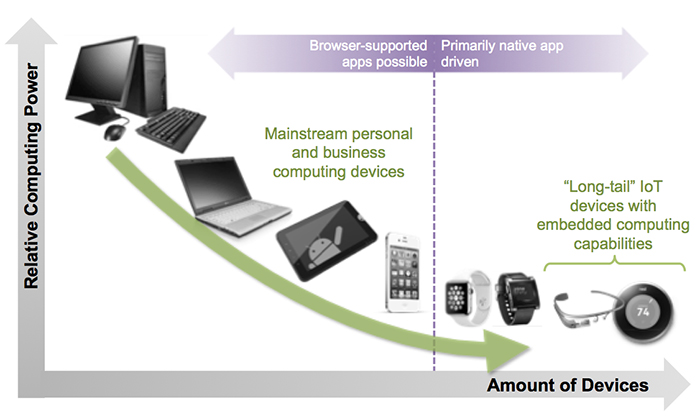Native mobile apps are going strong, with over 20,000 apps released per month on the iOS App Store alone in 2013. Despite this impressive trajectory, we expect a further exponential surge in the number of native apps released over the coming years. Before I explain why, let’s take a brief look back at the recent history of app development…
A Brief History of HTML5 and Native Apps
Remember those ongoing debates between HTML5 versus Native apps? If you’re like us, you view the discussion as somewhat pointless: pick the path that makes the most sense for your use case, audience, and app requirements.
Native/HTL5/Hybrid Comparison by Salesforce.com:

With charts like the one above, many organizations were (are) no doubt attracted by HTML5’s promise of cross-platform compatibility, ease of maintenance, and lower (perceived) total cost of ownership. With Phonegap/Cordova, hybrid apps also promised the best of both worlds: easier maintenance with native access to device features. In October 2013, a Forrester survey of mobile technologies used by US-based firmed found HTML5 and responsive design near the top, with 43% of respondents indicating they used both approaches.
Frankly, we would love to see HTML5, or mobile web apps more generally, succeed more broadly. However, HTML5 apps have their limitations, such as immature offline standards, lack of consistent support for browser-based native device access, and sluggish UI responsiveness if not meticulously tested. The same Forrester survey found that nearly 60% of the time, apps developed purely with HTML5 took longer to deliver than planned, with the biggest area of delay attributed to testing and fixing issues.
When properly used and implemented, HTML5 can be a great option for certain types of apps. If you are willing to invest in good design and code practices, you can even build hybrid apps that look indistinguishable from a native app. The original LinkedIn tablet app was a great example of a well-designed hybrid app, with a single native view and the remaining ones implemented in HTML5. While I often pointed to this app during my talks about cross-platform mobile development, barely a year after they started, LinkedIn announced they were abandoning the hybrid approach in favor of pure native. The primary reasons: memory issues and animation smoothness. There have been more recent announcements of companies switching from HTML5 to native, the most publicized of which was Facebook’s admission that native apps were superior.
Despite these facts, several technology journalists and pundits have continuously forecasted the death of native apps over the past several years. The MIT Technology review published an article called “Why Mobile Apps Will Soon be Dead” way back in 2011! The argument at that time, based on the thoughts of a former Google engineer, was that there were far more web users than iOS users, and therefore the distribution channels for native apps were limited. More recently, the Internet’s inventor himself, Tim Berners Lee, was quoted as saying that native apps were boring and he would prefer to see prefer to see companies and developers focusing more on building web apps using HTML 5.
Coming Soon: Massive Native App Proliferation
Against this rather pointless debate, there is a fundamental shift happening that will result in an exponential rise in the demand and number of published native apps. At some point in the fourth quarter of 2014, we reached an inflection point where there were more mobile devices on the planet than human beings. Smart phones and tablets are growing at a rate five times faster than our population. Even more impressive than these numbers will be the coming onslaught of web-connected devices, referred to as the Internet of Things (IoT) or Internet of Everything (IoE).
The IoT movement will result in the demand for apps that run on a plethora of non-traditional devices such as appliances, automobiles, thermostats, clothing and other fashion accessories, the list is endless. These connected devices will far outnumber the typical large-screen, high-powered CPU devices that apps – both native and web - have traditionally targeted, and will have neither large screens nor heavy-duty CPUs that are typically needed for a user to efficiently utilize a browser and web-based app. In addition, these new “app channels” will have far more specialized native device capabilities such as heart-rate monitors, atmosphere detectors, and other sensors that the HTML spec will not be able to accommodate for some time.

A combination of these three factors…
- Small, or no, physical screen
- Low CPU power
- Specialized hardware capabilities
Need for an App-Driven Enterprise Digital Infrastructure
Against this transformational technology backdrop, organizations will have to evolve their digital strategies to keep up with the proliferation of modern, connected devices. A backend services (BaaS or MBaaS) approach enables enterprises to establish digital infrastructure that meets the demands of both the current post-PC era, as well as the upcoming IoT paradigm. The numbers for the associated revenue opportunity as this shift takes place are staggering.
With an MBaaS solution, organizations can start to unlock value from their legacy IT infrastructure by mobile-enabling business processes that cut across one or more databases or legacy applications. Furthermore, an MBaaS approach exposes modern RESTful APIs and cross-platform SDKs that encapsulate critical business functionality on the server-side, enabling developers of any mobile or other connected endpoint to build apps more easily. Finally, a strong MBaaS solution also supports cloud, on-premise, or hybrid deployments, enabling enterprises to take advantage of cloud-based development speed, but also adhere to industry compliance and other security standards in hardened data centers when needed.
As we enter the fascinating world of connected devices everywhere, with native apps running on non-traditional endpoints such as appliances, automobiles, and personal clothing, it is imperative for enterprises to enable their developer ecosystems to build solutions that leverage these modern interaction paradigms. Enhancing your digital infrastructure with MBaaS solutions will help prepare you for this transformation.